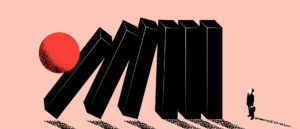
Building a career with impact in CSR
Creative and ambitious people that can help businesses shape and deliver their CSR agendas are in demand, says Lakshmi Woodings. Discover what careers in CSR involve and the skills you’ll need to succeed


While an optimal amount of stress can help you focus and perform better, ‘bad’ stress and anxiety can impair your ability, says the author of Beat Stress at Work, Mark Simmonds. That’s why your characteristics and your work must be a good fit
Fit is everything.
If you want to give yourself the best chance possible of enjoying a rewarding career – one where you are able to fulfil the loftiest of ambitions – it’s important that you’re able to choose a path where you are able to manage ‘bad’ stress as much as possible. One way of doing this is to treat your job in the same way you would treat a personal relationship. In other words, look for a job where there is a close alignment between your own values and those of the company. If there is misalignment between the two for too long, the pressure will mount and it will more than likely end in tears.
This is what happened to me when I kicked off my career. It was really painful.
The prolonged panic attack
In my early twenties, I started working for Unilever, the global consumer goods company – one of the largest in the world. Its household brands, like Dove, Axe, Knorr, Magnum and Domestos are available in around 190 countries.
Unilever also has one of the most respected management trainee programmes for young people who want to forge a career in marketing. I succeeded in joining it when I was 25, working for Birds Eye Wall’s, one of its operating companies at the time and I was pretty proud of my achievement. The career roadmap was now neatly laid out in front of me and the future seemed bright.
A year later, I found myself pacing up and down the basement of the Birds Eye Wall’s building liked a caged animal. I was alone, surrounded only by freezers full of frozen peas, beef burgers and fish fingers and my own confused thoughts. I was trying to work out why I was suddenly feeling so anxious, why I seemed incapable of completing the most basic of tasks at my desk upstairs. I needed a bit of head space, away from people, to think clearly and work out what was going on in my frazzled mind. At the time, I was only a trainee, the lowest of the low. Admittedly, I had now been handed a little more responsibility and people in the team were relying on me to get things done, but I was still a relatively insignificant cog in the wheel.
Yerkes, Dodson and the electrocuted rat
I didn’t know it at the time, but I was experiencing a prolonged panic attack. During those ‘basement wandering days’, I felt frightened and agitated all the time. Back in 1908, two psychologists, Robert Yerkes and John Dodson, discovered that mild electric shocks could be used to motivate rats to complete a maze, but when the shocks became too strong, they would start panicking and scurry around the maze haphazardly in an attempt to escape. This became the basis of the Yerkes-Dodson Law which suggested there is a clear link between performance and arousal.
For example, an optimal amount of stress will help you focus on an exam and remember all the key facts. You might feel energised, stimulated, even exhilarated. That is ‘good stress’ and this might help you perform even better. But too much anxiety can impair your ability to remember anything worth writing down on the exam paper. You might freeze and become incapable of thinking straight. That’s ‘bad stress’ when you might not even perform at all. For what it’s worth, I felt like that electrocuted rat.
A round peg in a square hole
When I was writing the book, Beat Stress at Work, I reflected back on that period and tried to work out what had gone wrong. What was it that had caused me to suffer from the prolonged panic attack and the years of discomfort that followed working at Birds Eye Wall’s? The problem was fit. I was a round peg in a square hole.
By nature, I was more of a creative type and enjoyed ruminating and cogitating, playing around with ideas and concepts, preferably on my own. I liked to have time and space to think things through. However, Birds Eye Wall’s was a fast-paced environment where making decisions quickly was very much the order of the day. Long ‘to do’ lists and pressing deadlines were very much the order of the day and all the beautiful inefficiency associated with the creative process was frowned on.
Matching careers and characteristics
I developed the Matchmaker to help people make good career choices. It identifies a number of characteristics that define the DNA of both the company and the individual. The goal is to try and ensure that there are as many matches as possible, because the more matches there are, the more aligned the needs of both parties will be, and the less likely that ‘bad’ stress will rear its ugly head.
You can see in the Matchmaker table that in the case of Birds Eye Wall’s and me, that it was only ‘team orientation’ where alignment existed. For crucial pairings such as ‘focus on people development’ vs. ‘focus on task completion’ and ‘bias towards introverts’ vs. ‘bias towards extroverts’, the company and I were misaligned. Over a period of time, this misalignment began to cause me more and more ‘bad stress’.
So, how do you use the Matchmaker?
1* If your current job is causing you significant ‘bad’ stress, use this framework to highlight the differences that exist between you and the company, dimension by dimension. Put your name and your company’s name in the relevant boxes and insert a star where your names appear side by side.
2* Use the completed framework as the basis for a constructive conversation with your employers to see if you can achieve greater alignment. Be prepared to discuss the source(s) of your stress. Try and agree what they can do, what you can do.
3* Alternatively, if you are on the lookout for a new job, then use the dimensions of the Matchmaker to help you identify companies/positions where there is likely to be greater alignment between you and them.
Remember that fit is everything. Don’t be a square peg in a round hole if you can avoid it.
Mark Simmonds runs a creativity agency called GENIUS YOU and is the author of Beat Stress at Work.

Creative and ambitious people that can help businesses shape and deliver their CSR agendas are in demand, says Lakshmi Woodings. Discover what careers in CSR involve and the skills you’ll need to succeed

From data analysis to chatbots, technology is already playing a big role in marketing and STEM graduates are well-positioned to harness the benefits, says RAPP’s Head of Client Success Imogen Tostevin

Whether you’re a business owner, leader or employee, there are things you can do to ensure you’re ready to withstand any economic crisis that comes your way. Find out what with these top tips
For questions about editorial opportunities, please contact:

